#convert vinyl to digital
Explore tagged Tumblr posts
Text
How to Digitize Your Vinyl Records
Vinyl records, with their warm sound and nostalgic appeal, have experienced a resurgence in popularity. However, their physical nature can make them susceptible to damage and deterioration over time. Digitizing your vinyl collection offers a practical solution to preserve your cherished music while enjoying it on modern devices.
Why Digitize Your Vinyl Records?
Preservation: Digitizing your vinyl records protects them from wear and tear caused by repeated playback.
Accessibility: Enjoy your music on any device, anywhere, without the need for a turntable.
Noise Reduction: Digital editing tools can help remove surface noise and other imperfections.
Sharing: Easily share your music with friends and family.
Equipment You'll Need:
Turntable: A good quality turntable is essential for accurate playback. Look for a model with a high-quality phono preamp.
Phono Preamp: If your turntable doesn't have a built-in phono preamp, you'll need an external one to amplify the low-level signal from the cartridge.
Audio Interface: This device connects your turntable to your computer. Choose one with high-quality audio inputs and outputs.
Computer: A computer with sufficient processing power and storage space.
Digital Audio Workstation (DAW): A software application like Audacity or Adobe Audition for recording and editing audio.
Audio Cables: Connect your turntable, phono preamp, and audio interface using high-quality cables.
Step-by-Step Guide:
Set Up Your Equipment:
Connect your turntable to the phono preamp using a phono cable.
Connect the phono preamp to the audio interface using an RCA cable.
Connect the audio interface to your computer using a USB cable.
Install Your DAW:
Download and install your chosen DAW software.
Configure Your DAW:
Set up your audio interface as the input device in your DAW.
Adjust the input levels to avoid clipping.
Start Recording:
Create a new audio track in your DAW.
Press the record button and start playing your vinyl record.
Monitor the audio levels and adjust as needed.
Editing and Mastering:
Once the recording is complete, you can edit and master your audio in your DAW.
Remove any unwanted noise or pops using noise reduction tools.
Adjust the volume levels and equalize the sound to your preference.
Export Your Audio:
Export your audio files in a high-quality format like WAV or FLAC.
Tips for Optimal Results:
Clean Your Records: Clean your vinyl records before playing them to reduce surface noise.
Use a Good Quality Stylus: A worn-out stylus can degrade sound quality.
Level Matching: Ensure that the audio levels are consistent across different tracks.
Batch Processing: Use automation tools in your DAW to process multiple files efficiently.
Consider a Vinyl Ripping Service: If you're not comfortable with the technical aspects, consider using a professional vinyl ripping service.
Conclusion
Digitizing your vinyl records is a rewarding process that allows you to preserve your musical heritage and enjoy it in the digital age. By following these steps and using high-quality equipment, you can create digital copies that rival the original vinyl experience.
Impress Vinyl: Your Source for Quality Vinyl Records in Australia
If you're a vinyl enthusiast looking for high-quality records, consider checking out Impress Vinyl. They offer a wide selection of new and used vinyl records from various genres, ensuring that you'll find something to satisfy your musical tastes.
Source: Convert vinyl to digital
0 notes
Text
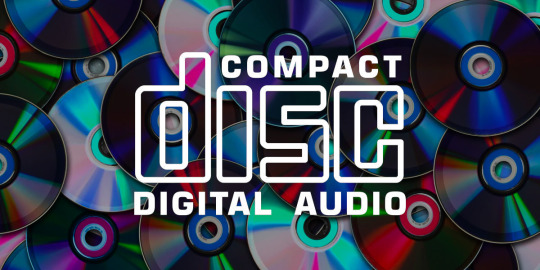
A few people took exception to calling my car's CD player useless.
I actually think it is great there are a few holdouts still using CDs.
CDs are truly one of the most perfect media ever created.
And I can prove that mathematically.
Some will say vinyl is superior. And as much as I love records, the audio quality is preferred, not better. People have a *preference* for how vinyl sounds, but it still leaves out audio information and has noise and artifacts caused by the mechanics of the turntable and an imperfect manufacturing process.
In fact, the lesser audio quality is exactly what people enjoy. It has a warmth and comfortably compressed dynamic range that is not fatiguing over long listening sessions. It's like choosing a nice fire over a 100% efficient space heater.
But if you want perfect audio quality that does not exceed the limits of human hearing, compact discs are where it's at.
It all has to do with Dr. Harry Nyquist and his Nyquist-Shannon Theorem. (Sometimes Shannon gets left out and it is just called the Nyquist Theorem.)
The simple version is he figured out how much something needs to be sampled in order to not lose any information. As long as you sample something at a frequency greater than or equal to twice per cycle, you will have a lossless... whatever.
In this case, a lossless audio recording.
So the range of human hearing is about 20 Hz to 20 kHz. That's the lowest and highest frequencies we can perceive. The scientists creating CD audio figured they'd do 22 kHz for some overhead and then you double that to get 44 kHz. (Technically it was 44.1 kHz.)
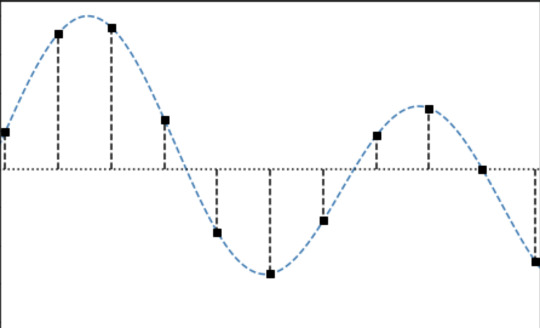
You can imagine the smooth curvy line as an analog recording. No gaps. No information loss.
The black squares are digital samples recorded over a period of time. You can see there are gaps between those black squares. A tiny bit of time passes between the squares where nothing is sampled. INFORMATION LOSS! NOOOOO!
Clearly the vinyl nerds are correct and digital is inferior, right? You are going to get the dreaded... STAIR STEPS!
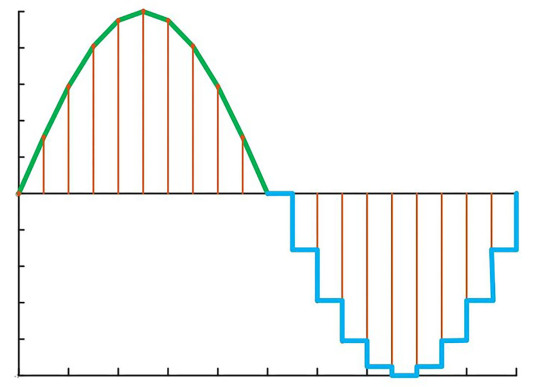
Not so fast, bucko!
By getting enough samples over a period of time, you can use math to infer that smooth sloping line connecting those individual samples. So the digital recording also has no information lost once it is converted back to analog and played through your speakers.
This connecting of dots is called "interpolation."
You could take the curvy analog, convert it to digital, get the same black squares, and then interpolate the black squares back into analog and get the same curvy line. It goes back and forth perfectly. And this is all verifiable with an oscilloscope.
NEAT!
Then of course you need a good dynamic range--the spectrum of quiet to loud. Anything above 85 decibels will damage your hearing, so they went with a 16-bit depth which covers roughly 100 dB. Again, giving them a little overhead for death metal and overzealous trumpet players.
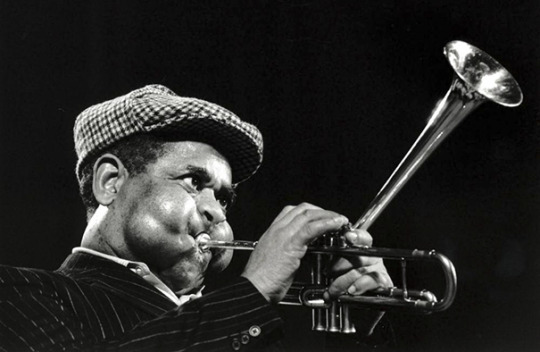
And the final component is data bandwidth or "bitrate" usually measured in kilobits per second. This is how much data is read every second. The 1s and 0s of it all. The bitrate of a CD is calculated by multiplying 44,100 samples per second per channel by 16 bits per sample and then multiplying by 2 channels. After all that mathing is math'd, you get a perfectly uncompressed 1,411 kbps.
So you've got all the frequencies you could ever hear combined with as much volume as your ears can stand with a bit rate that will give you no loss of data.
The *perfect* audio quality all encoded into little microscopic pits.
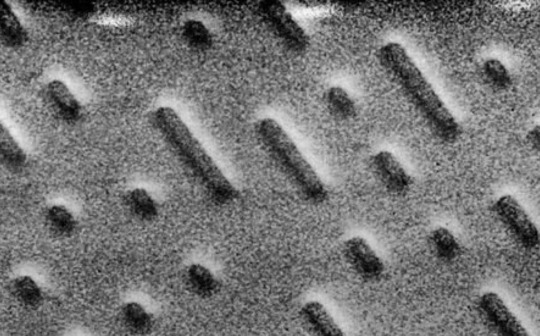
Now you may be asking, "Why do I see "24/96" or "24/192" advertised on fancy audio equipment and high quality streaming platforms like Tidal? Aren't 24 bits better? Isn't 96 kHz MORE than 44.1 kHz?"

Dr. Nyquist might say... this is some bullshit.
This confusion comes from the fact that recording quality and playback quality are two different animals. This misunderstanding happens with video and photo quality as well. Recording in 6K will give you a sharper picture even if your final playback quality is 4K. You can get bad pixels and noise and stray photons that do not contribute to the detail in the video. By giving yourself overhead you can ensure you hit the desired quality target.
And recording at 24 bits and 96 or 192 kHz, you get a higher resolution to edit and master with, but it is only advantageous to the computer software... not the human ear.
From a photographer's perspective, I relate to it like this...
If I have more megapixels and more colors and more dynamic range I have more leeway when editing my photos. If you try to push a low quality photo in the edit, it has this tendency to fall apart. You can get ugly color banding and harsh contrast and sharpening artifacts. By capturing more quality than you need in the finished product, you can process the photo much more dramatically before it deteriorates and loses integrity.
Audio and video are the same way.
So let's say you have a metal singer that screams at the microphone as loud as possible from 2 inches away.
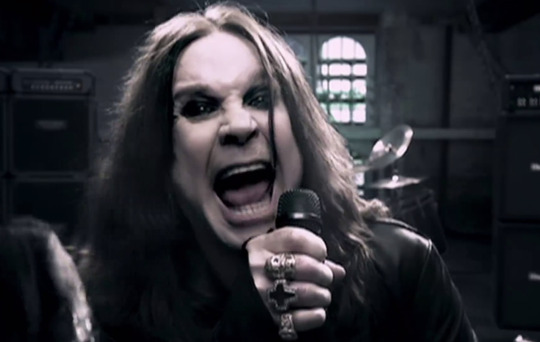
At 16 bits they may surpass that 100 decibel dynamic range and distort the recording. But if you record in 24 bits, you get 144 dB to play with. Or you can even do 32 bits and get 1500 dB--a volume that no human voice could ever surpass. It guarantees a clean, distortion free recording, but 32 bits would be pointless for human listening.
The same is true with the sample rate. Having a higher resolution allows you to zoom into waveforms and adjust things to an extremely granular level. You can do precise timings, tiny pitch adjustments, apply loads of digital effects, and just have more room for audio activities without degrading the sound quality.
But outputting 192,000 of those black squares is going to interpolate the exact same smooth curvy line as 44,100 when it is played through speakers.
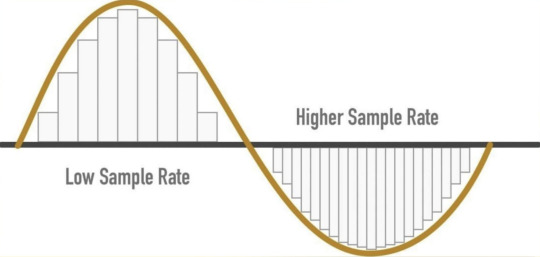
The oscilloscope knows what I'm talking about.
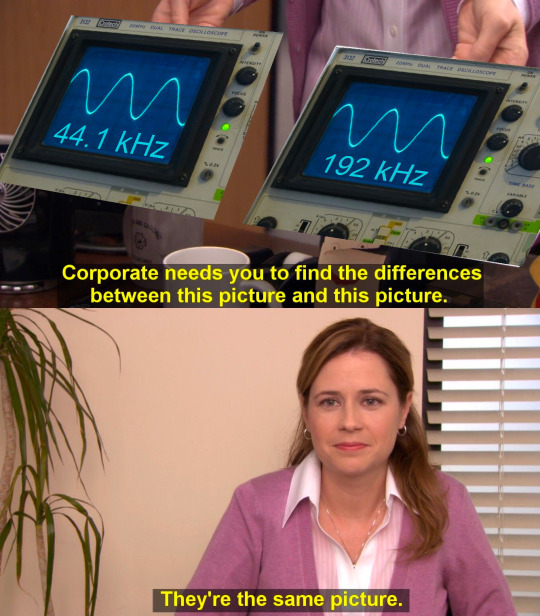
Now I am about to reveal a secret that no audiophile who has invested in a $115,000 high resolution 32 bit/3,072 kHz DAC wants to acknowledge...
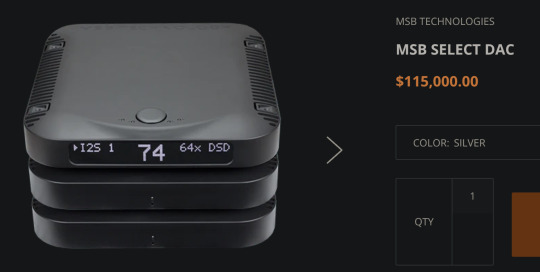
The master recording is always more important than the playback quality.
If you have a high quality source it will sound great even in a highly compressed MP3. Just like the 6K video is sharper on the 4K TV. And the high megapixel photo looks better in an Instagram post.
If the source is good, the media will be good.
And since high resolution audio services often seek out the best masters available before encoding their playback files, it gives many people the illusion they are getting better sound quality due to the boosted specs.
When in reality, it was just a better copy of the original recording.
According to Nyquist, your human ears are not computers and all you need is double the frequency to hear perfect sound with no loss of information. So anything above 16 bit/44.1 kHz/1411 kbps and you are just wasting bandwidth on a server.
And I don't want to hear anything about "stair stepping."
IT'S MATH.
Your ears aren't better than math, okay?
If you don't believe in math, then you and Jack White can sit in the naughty math corner with his bespoke overpriced vinyl pressings.

I will say, there is a gap between your standard music streaming service like Spotify and your bullshit audiophile service like Tidal.
Free Spotify uses heavily compressed files. Which means the bitrate is quite low and there can be information loss. Or "lossy" compression. Modern compression is actually pretty amazing, but I'm afraid anything below 320 kbps may cause some songs to not sound as intended.
Depending on the content, some songs are more suited to compression than others. And even with premium Spotify, they cap songs at 320 kbps which still may not be enough for busier, harder-to-compress songs.
Also, I don't know if Spotify cares about getting the best quality master for a given song. Which, again, is the most important aspect of sound quality.
But services like Tidal waste bandwidth with their super specs and that isn't great for the environment. What I'd love to see is a company that makes their best effort to seek out high quality masters, and encodes their files at 16 bit/44 kHz with a lossless variable bit rate compression. Variable bit rate or "VBR" will do more compression during simpler parts of the audio and less compression during more complex parts. It's smart compression, basically. And as long as you use a high enough bitrate to achieve lossless compression, the sound quality will be the same as if there is no compression at all. So you still get smaller file sizes that use less bandwidth and have a smaller environmental impact.
That would be a streaming service I would consider paying for. Especially if they put great effort into getting high quality original recordings for their content.
In conclusion... if you are still using CDs you don't need to worry about audio quality. You're all set. There is a sort of beauty in what the audio scientists who created compact discs did. They figured out the limits of human audio perception and created a format that just slightly exceeded that. No "bigger number is better" marketing. No audiophile bullshit.
They said, "Here is what you need and nothing more."
They made a perfect thing and they should be proud of that.
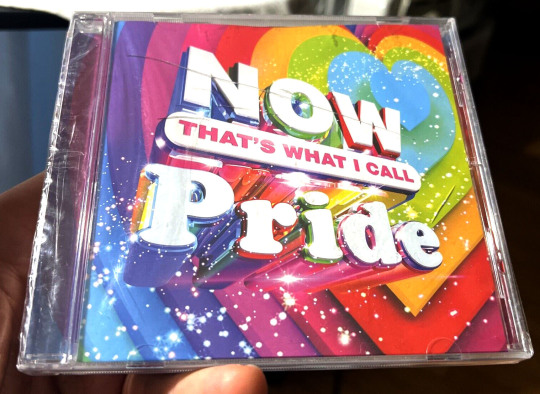
435 notes
·
View notes
Note
hey! sorry to bother you, but is there anything a teen without transportation in a rural area can do on their own? im pretty isolated, and theres barely anything around me.
Hey ya sprout 🌱
**A disclaimer Punk comes with some risk socially. Particularly if your in a rural area this risk goes up bc people Know You and also typically these spaces have a different vibe to alt ppl in general. Some activities are more or less risky and I'll try and do my best to give you a range of stuff from the whole spectrum! Of course this is a generalization of rural areas. Some palaces will be more cool then others depending in so many factors I couldn't go into here**

Rural solarpunk
Your gunna been to pick a topic, sorry babe. In order to not burn yourself out and in order to feel like you have an impact your gunna have to pick a cause to chip away at but I'll give you ideas! And remember just bc your focusing on one thing doesn't mean your ignoring or not helping others. Everything is interconnected and any help, helps all!
So let's give you some ideas to focus on:
Libraries- as a teen in particular you'll have access to a library at school, but depending on how big your town is you might have a public one as well. Become their biggest supporter! They are a great safe space, even conservative ones are still a good place to go for archiving/loitering purposes. They give you spaces to print stuff, to build clubs and community.
Archiving- if you cannot leave your house due to access you can always do stuff online and hear me out, i know when we do stuff online it feels like half points. Like we arent doing anything. I feel that with this blog, it feels so passive no matter how hard you work youll feel lesser. But Archiving is vital to humans! Think of the anthropologists wholl thank you down the road! Plus it does actually give you a way to have a physical representative of work your doing. Dvds, pirating media and archiving them to drives, collecting vinyls/tapes/cds!
DIY- To fight against fast fashion (although that barely exists in the towns I've been in tbh) and to stick out** you could make your own patches, battlejackets, gloves, etc.. They are statement pieces you can wear whenever your in town/at school/social spaces that ppl know what you stand for and who you are. Depending on who/where you are this might be risky so take what you can bare ok? You don't have to wear these items too you can just make them for later on!
Little libraries/little pantries- in a rural space you have more Gruella tactics you can take if you do them in random abandoned spaces. You could build a waterproof little pantry and stock it and leave info somewhere about it for ppl to drop off/pick up items. Stock it with mittens! With canned goods! With books! You might be able to do a space like this at school/library depending in how cool your town is too!
Zines- You could look into making a zine and even if it's digital you could have the QR code for download in places (stickers on lamp posts, flyers in school bathrooms, hidden in a churches pamphlet stacks >.>) making a zine is a cool task that is time consuming and informative and fun!
Vandalism- like I said you can often print off stuff at Libraries, or usually you can find a place to print stuff off near or at post offices depending on how modern your rural space is. if you have your own printer this will reduce your risk by quite a bit though! Create/find stickers or posters you want to toss across town or even school. I'd recommend starting off with some stickers and see how their handled, dipping your toes is important with these kinda things. If your really feeling it, and you know some abandoned places Moss Graffiti is also a good option! I've know ppl who have converted old abandoned stored to skate parks (I honestly have no idea how they built the ramps out of concrete but damn!! Good job guys!)

Also I'll leave you with 2 book recommendations as well-
Moxie - a RIOT GRRRL story about a girl who gets so fed up with her conservative town she makes a feminist zine and distributes it via girl bathrooms (even having a basically me too stickers and encouraging ppl to put it on boys lockers who have assaulted them). I know there's a movie, didn't seem to capture the same vibe tho so book!
Braiding Sweetgrass - this focuses a lot on reconnecting and adding story to nature around us and having science along side spirituality
#sporut guide#reaping week#solarpunk#hopepunk#anticapitalism#punk#rural#cottagecore#community#ecopunk#direct action
261 notes
·
View notes
Text
My headcannons for what type of music the Batfam likes lol
Bruce: 40s love songs, mostly because Thomas and Martha are lovers of old music and art it’s a call back to Batman being such an old.. old character.
He also loves really, REALLY sad songs. Just straight depressing songs, like he knows all the lyrics to like the most downright suicidal songs ever.
Dick: he listens to very upbeat music, but like EDM and rap, he also loves circus music and really ridiculously old songs he knows all the words to “the flying trapeze” by heart ❤️
Jason: unironically his favourite album is Neil Cicirega's "mouth sounds" series of albums, he also would never admit it but he listens to Kikuo constantly. he's not a "fan" of vocaloid he just likes some songs. he also constantly listens to 80s and 70s hits as a call back to his character being popular in the 80s.
Tim: worst taste in music ever, he does NOT get the aux. it's all the most popular hits of the last 4 decades, for better or worse.
he also gets all the WE jingles stuck in his head, it's so bad.
it's mostly now video game OST's he got into FNAF lore at one point and actually solved it, and then got super into the music. he relates a bit too much, he calls Jason sometimes mike because they are both undead guys hellbent on keeping kids safe from the evils of this world, and Ra's afton because the bastard always comes back. he will BLARE "I hope you die in a fire" when working a Ra's case.
Damian: despite what he holds himself to he really likes the same fandom sorta music, video game lore was the only thing that Damien and Tim talk about, they have usually ZERO free time to watch or play games they just extrapolate wtf the game is about from their friends WITH free time. that being wally and bart.
so damien has a bunch of the living tombstones, classic Chinese and arabic music but mainly Pakistani, some 80s hits. 40s love songs because bruce is right they are really good, and some mislabeled cassette tapes\CD's Damien picks up on patrol that he likes.
Steph: she didn't really get a chance to listen to much music, since Cluemaster was a dick. but she did bond and learn to love Ballet music ever since Cassandra introduced it to her, she gets whole records and albums and buys one time releases on Ebay for herself and Cassandra. otherwise she just listens to audiobooks or podcasts when working.
Cassandra: TONS of ballet music along with classic Oprah music and theatre music, she goes to plays and pirates them, she listens to every single play or theatre music she can get her hands on. she listens to "rocky horror picture show" "the guy who didn't like musicals" "Coppélia" "Jesus Christ superstar" "The Mousetrap" any and everything. she adores it all, she and Steph are constantly looking for more records and plays to watch and pirate.
Barbara: weirdly enough 60s music, Jim rubbed off on her and she honestly just listens to all sorts of 60s sounding music, she had a Elvis phase where she just was constantly listening to Elvis, eventually she found out there was a TON of other 60s and 70s black artists who were ripped off by Elvis and started listening to them, she then eventually got into punk rock and rock and roll.
Harper: she is fully into the Gotham punk music scene, she literally is one of the biggest supporters of the Gotham punk scene. only random punk song CD's, videos she converted into CD's, old gothamite punk songs on vinyl, digital releases, she just has so much merch half she made herself and half she bought, she is the epitome of Gotham punk fan. she actually has a whole ass internet archive account dedicated to JUST Gotham punk.
Duke: weirdly he loves very ethereal and bright peppy music, only instrumentals though, listens to the weirdcore playlists on YouTube listens to corecore, he just has very strange music tastes.
sometimes he forgets his entire playlist is filled with weirdly ethereal music and the rest of the batfam get so confused, and think Jean-paul is blaring church music again.
Jean-Paul: only church music, he has the most bland music tastes, he sometimes listens to catholic metal or something when he's working but other than that he just blares organ music and mass and church music, everyone tries to tell him that he CAN LISTEN TO ANYTHING ELSE. PLEASE. but he just doesn't lol.
Thomas: he listens to 40s love songs and old Sicilian and Italian songs, he's a old fart, he loves old movie soundtracks.
William Cobb: circus music only circus music, late 1880s and 1950s circus music. it sounds like a clown house and it triggers the shit out of bruce.
Jarro: he's a baby, he has no actual opinions the batfam put on nursery rhymes andcoco melon
and the rest (carrie, Bernard, huntress and the other ones)
I have 0 idea I have not read enough comics to figure it out lol
#-pop#batfam#batfamily#batfamily headcanons#bat family#bat fam#the batfamily#alfred pennyworth#jason todd#dick grayson#harper row#jarro the starro#jarro#batman#dc comics#Tim drake#damien wayne#Thomas wayne#batman headcanon#William cobb#talon dc
46 notes
·
View notes
Text

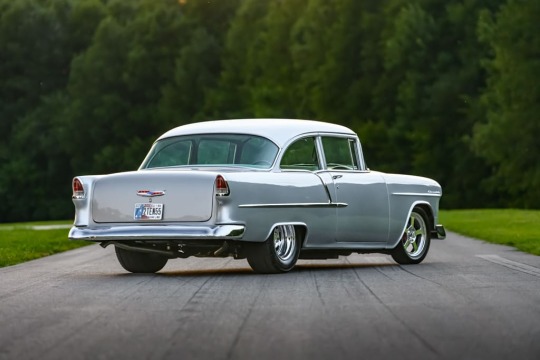
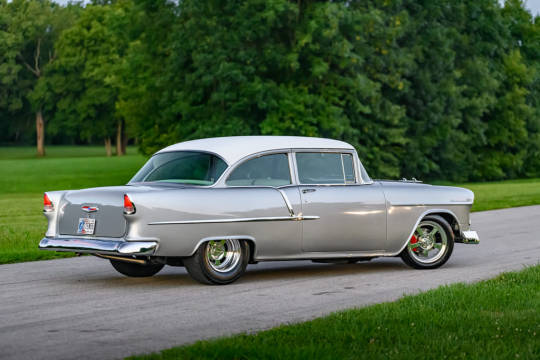
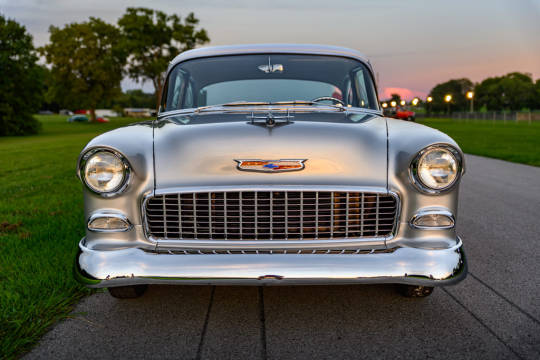
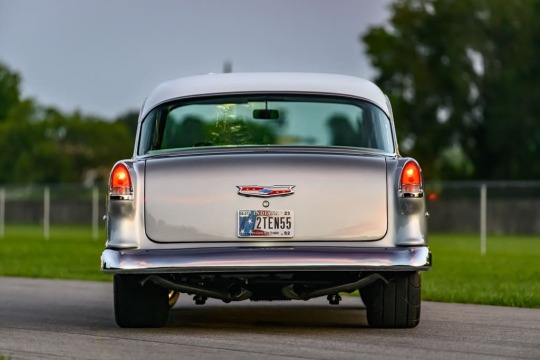
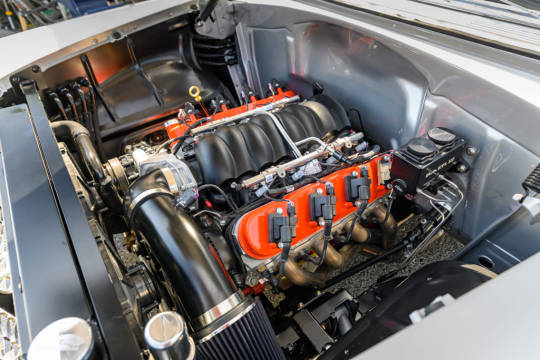
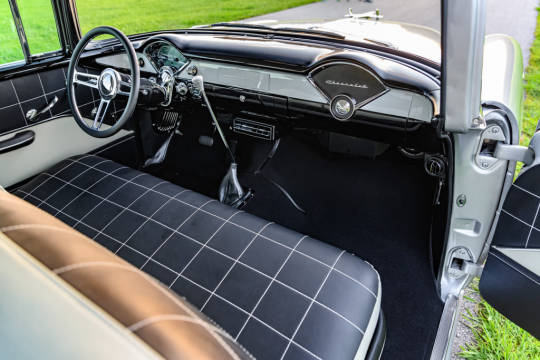
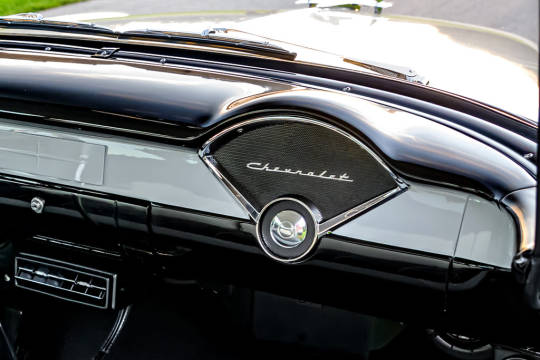
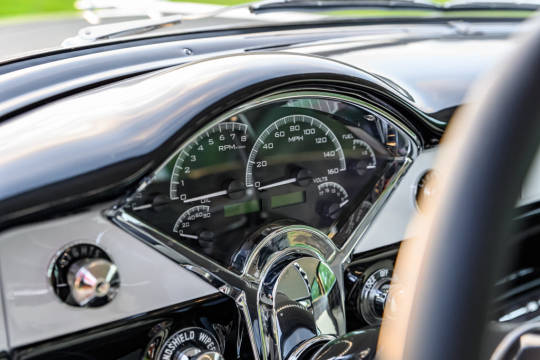

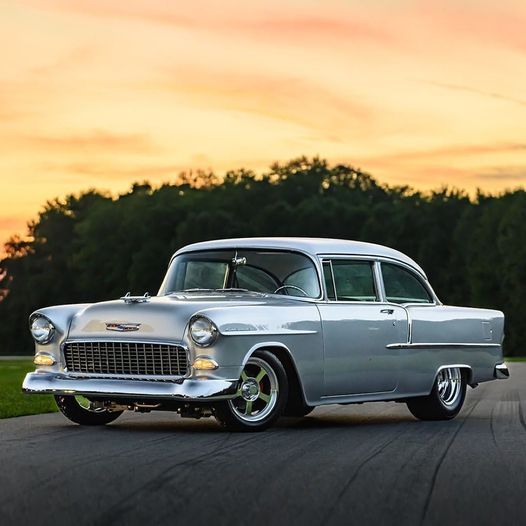
1955 Chevrolet 210
TECH CHECK Owner: Eric Mead, Evansville, Indiana Vehicle: ’55 Chevrolet 210
Engine Type: BluePrint Engines Chevrolet LS3 Displacement: 376 ci Compression Ratio: 10.7:1 Bore: 4.070 inches Stroke: 3.622 inches Cylinder Heads: BluePrint Engines aluminum Camshaft: BluePrint Engines hydraulic roller (0.612/0.585-inch lift, 225/238 deg. duration) Ignition: E38 Engine PCM Assembly: BluePrint Engines Exhaust: Church Boys Racing by Stainless Works 1-7/8-inch primaries to 3-inch collector and 2.5-inch stainless pipes bent by Dave Favor’s Performance Exhaust, MagnaFlow Mufflers Ancillaries: Holley mid-mount accessory drive, PRC radiator and core support, SPAL Fans Output: 530 hp at 6,100 rpm, 508 lb-ft at 5,200 rpm
Drivetrain Transmission: ’99 GM 4L80E Automatic with TransGo valvebody kit prepared by Wathen’s Transmission (Owensboro, KY) Torque Converter: FTI Billet 3,200 stall Driveshaft: Driveline Plus Rear Axle: Strange Engineering 9-inch with Truetrac differential, 3.70 gears, 35-spline axles
Chassis Chassis: Roadster Shop SPEC Front Suspension: Strange single-adjustable coilovers, stabilizer bar Rear Suspension: Strange single-adjustable coilovers, parallel four-link, Panhard bar Brakes: Baer four-wheel disc, 12-inch front rotors with four-piston calipers, 11-inch rear rotors with four-piston calipers, Baer Remaster master cylinder
Wheels & Tires Wheels: Bogart Racing Wheels D-5; 17×4.5 front with 2.25-inch backspace, 15×10 rear with 5.5-inch backspace Tires: Mickey Thompson Sportsman S/R front, 26×6.00R17; Mickey Thompson ET Street S/S rear, 295/55R15
Interior Upholstery: Holtsclaw Custom Upholstery (Francisco, IN) Carpet: Cars Inc. black loop carpet Seats: Original bench seat with black-and-white vinyl Delray pattern Steering: Summit steering column with Eddie Motorsports steering wheel Shifter: Lokar Dash: Original Instrumentation: Dakota Digital VHX HVAC: Vintage Air Wiring: American Autowire by Andy’s Hot Rod Shop (Mulkeytown, IL)
Exterior Bodywork and Paint: Reisinger Custom Rebuilding (Evansville, IN) and Andy’s Hot Rod Shop Paint: Sateen Silver/white by James Smith of Road Runner Restorations (Johnston City, IL) Hood: Stock Grille: Danchuk Bumpers: Danchuk Glass: Auto City Classics Fuel Tank: 15.5-gallon Tanks Inc. galvanized powedercoated silver
105 notes
·
View notes
Text
Ineffable May 2024, Day 5: Retirement
Rated General Audience
There was more salt than pepper in Nina’s locs these days, and she was beginning to appreciate a mug of something hot less for the caffeine content and more for the soothing warmth on the overworked joints of her hands. Today, though, her hands were empty as she waved one over the small black screen installed on the wall just inside the kitchen door of Give Me Coffee or Give Me Death. The movement woke the alarm system’s AI and a cheerfully neutral voice addressed her.
“Hello, Nina. Leaving for the day?” The face recognition software had records of all of the shop’s employees, and was programmed to know who was due to open and close based on the work schedule. Or rather, it had been programmed with that information until about a week ago. Currently, the only person it had on file was Nina. Soon, it wouldn’t even recognize her. Her smile was a little sad as she answered the now-glowing screen.
“Yes. Lock up after I’ve left, please.”
“Sure thing! Have a good night!”
“Thanks.” Nina exited the swinging door that separated the kitchen from the dining area. She paused before crossing to the front door, and could almost hear the bustle of a morning rush around her. She had spent decades behind a counter, offering the people of Soho the best drinks and pastries she could muster. During that time she'd seen old friends come together to enjoy each other's company, stressed students pounding away at keyboards, couples falling in love, and families grow. There had been so much life, both hers and others, lived within these walls.
When she was finally ready to leave, Nina’s steps echoed in the empty space. The next tennant was converting the storefront into a salon, and hadn’t wanted any of the furnishings. So, Nina had sold or donated it all. She’d kept the miniature Statue of Liberty, though, and it now held pride of place on the fireplace mantle in the little flat Maggie and she had just downsized to. Everything else had gone within the last few days.
The doorknob felt so familiar in her grip, and it seemed odd to think that this would be the last time she would turn it. Turn it she did, then stepped onto the pavement and let the door close behind her. She heard the snick of the lock sliding into place and knew that the system had done its job.
“Ready?” Maggie’s voice was soft, and there was no rush or ugrency behind it. Nina took in a breath and nodded.
“All done. I just need to leave the keys with the estate agent on the way home.” She slipped her hand into her wife’s, and they began the walk that would take them past the office and to their flat. Maggie’s eyes crinkled at the corners with her smile when they passed The Small Back Room. Through the big window, she could see Tony helping a customer sort through a selection of vinyls. Nina didn’t have to hear him to know that he was expounding how you just can’t get the same sound from digital, and isn’t it amazing how physical media really connects us to music in such a tactile way. Their son had inherited Maggie’s love of the record shop, and had happily taken on the responsibility of the day-to-day running of it when she’d decided to take a step back from the business.
As they approached the estate agent’s office, Nina realized that she really didn’t feel like going in and doing the whole smile-and-shake-hands-and-small-talk ordeal that inevitably came with these sorts of interactions. Fortunately, the building had a little brass flap on the exterior for people to deposit paperwork and what-not after closing. So, she just dropped the keys in that, and heard them clank into the little box that caught them.
“I don’t feel like cooking tonight. How about we pick something up?” The two women took their time strolling down the busy street, discussing the merits of the various restaurants between here and their flat. The air was cool, but not quite cold enough to make them want to quicken their pace. They eventually settled on a new Italian place and, once home, enjoyed the steaming containers of pasta in front of a warm, crackling fire.
-----
Want to play along? Check out the prompt list from @blairamok.
12 notes
·
View notes
Text
CATCH UP 。*・♡;
tagged by @waterdeep, thanks for the tag! i love doing these fun tag games <3
LAST SONG: 16 psyche - chelsea wolfe audiotree session
CURRENTLY WATCHING: re-watching the x-files but doing it super slow to last me through the year
THREE SHIPS: mulder x scully, roslin x adama (sweet old people slow burn romance just really gets me), misty x nat (as a romcom that somehow turns into a thriller)
FAVORITE COLOR: any shades of burgundy/wine red
CURRENTLY READING: nothing at the moment since i'm focusing on some podcasts, but i'm planning to go through some of @/queer-ragnelle's arthurian re-telling flowchart this year, which you can find here.
CURRENTLY CONSUMING: i want to learn to cook korean food so that will be my focus for meal prep this month!
FIRST SHIP: i don't really remember?! probably something like aragorn/arwen or any other media i saw as a child...?
PLACE OF BIRTH: philippines *mariah carey plays in the background*
CURRENT LOCATION: australia
RELATIONSHIP STATUS: i rarely speak on it because i am so private but it's lovely to be in a healthy/strong relationship for a long time.
LAST MOVIE: lisa frankenstein (2024)!
CURRENTLY WORKING ON: archiving my physical music collection - ripping CDs, converting vinyl + cassettes to digital...it is a huge undertaking, but i have the equipment to do it and it is very important to me!
tagging: @tinybaphomet @brightmoontor @shirubajiken @southsaturndelta @bathshebas @not-tyrannosaurus-lex @rencsplatts @leojurand but also anyone reading this is welcome to do this i'm just so bad at remembering URLs :(
7 notes
·
View notes
Text
I was talking with a guy.
Hey if I am mentioning it here it was about audio.
The question was how to get started in serious audio (lets not call it audiophile yet). It is a remarkably simple and yet complex question. Spend lots of money?
So to start, the front end is the tricky bit. That is source and control. Source is what you are listening too. Control is selection of source, if you have more than one, and basic volume control. In most systems control is the preamplifier.
The back end is the speakers and power amplifier. Actually really simple. What fits in your home and how much can you afford. Easy to change if you want.
The first big issue is source. By that I mean hard copied media or virtual. The first is category is CDs and their ilk such as SACD etc, and of course Vinyl LPs. The second is streaming online.
The second one first. (interesting sentence that but perfectly correct)
Streaming is far from simple. It has the least initial cost for the media as it is just a subscription fee (forever). It has an enormous even overwhelming variety and quantity of content. It also is only permission to use the content, but you do not own it. You can have a huge "collection" but it is virtual. Also there is a controversy about payments to artists.
Often not said is that almost all the streaming services are at or below CD quality. CD quality is not considered truly great by the tribes. That is all I am going to say about that right now.
The hardware is not simple for high end streaming. In very general terms you need a DAC (Digital to Analog Converter), a box to buffer or hold the downloaded files, and a computer to do the downloads and host the streaming service software. That is three boxes. In high end they are all expensive of course.
There are devices that do all three things, but they are not cheap. They also do not have the quality of the "best" systems.
Audiophiles like dedicated computers and streaming servers and DACs of eye watering expense.
In summary the streaming front end is very expensive. In my looking about for adding that to my system it is thousands of dollars. Conservatively about $5000 for my quality goal. Emphasis on that is only the front end.
Now to my thesis.
I say the least cost path to high end sound is with vinyl. WTF?! A high end capable Turntable starts at hundreds of dollars. Much more can be spent, but in today's local classified ads there are dozens under $500 and a few very good ones up to $1000. An older model refurbished unit is perfectly fine for the job. And I mean high end sound extraction. Brands such as Technics, Rega, Thorens, Micro Seki, Kenwood, Pioneer are good candidates.
A high end phonograph pickup or cartridge can be had for under $500 bucks. I have three all around $400 ish or less. I like Grado, and Audio Technica. There are more, but I don't have any of those. Moving coils need not apply. Those are euphonic, which is they add seductive sounds that are not in the source material.
That is the whole vinyl source hardware list. Under $1400 bucks or less and you are up and running. The only caveat is your control preamp needs to have a phono input which most old ones do.
In my case have a high end hybrid tube FET preamp that can be had for $2000 or less depending on the phase of the moon. You need that anyway. My opinion is the preamp is the major contributor to the overall performance of your system.
So that brings the full front end to less than $3400 for a high end system. If you take into account all my extra phono cartridges I still spent less than that. Just.
There is an intriguing option in a high end integrated amplifier from Technics (SU-G700) that is a preamp and DAC and very good class D amplifier with a phono input for about $2400 USD. Just add speakers and turntable and you are over the threshold to high end. It is rather spooky. If I had to start from scratch I would be tempted. Far less than an ARC suite. I could no longer claim I was a Luddite though.
Yes with vinyl you still have to buy LPs, unless you are an old fart like me and have hundreds, but it is actually rather fun. Compared to the initial cost of a high end streaming system the cost of an extensive LP library looks reasonable. I search for high quality boutique stuff usually, but I also find stuff in the racks. Garage sales anyone?
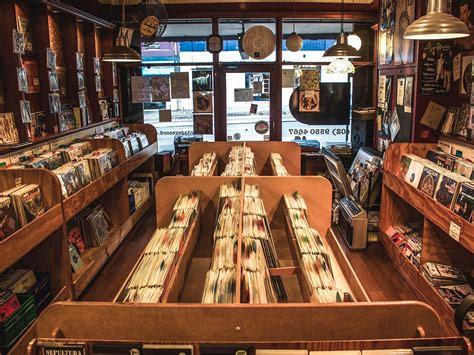
I have high end sound in my home. I dare say it is the best sounding system I have every heard. Vinyl is not a compromise. There is a lot to be said for getting up to flip a record every 20 minutes. Hell I have a watch that nags me to get up and move if I stay seated for more than an hour. (yes I am a geek) It's good for you Mr couch potato.
Obviously to play at this game money will be spent. You can start off modestly and build over time (decades in my case) or jump in. In the end you will have a sonic place to spend time appreciating art at the highest level.
Interesting that I really cannot afford to add high end streaming to my system. I don't need to.
#audiophile#high end audio#vinyl#turntables#audio technica#grado cartridges#least expensive high end system
7 notes
·
View notes
Text
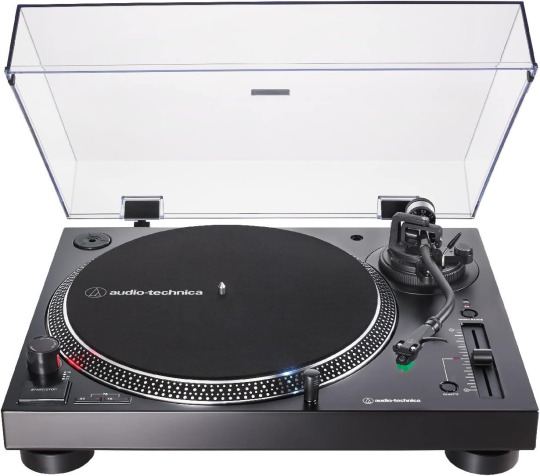
Prime Day Deal
$278.99 with 20 percent savings-20% $278.99
3 notes
·
View notes
Text
Round 2 Poll 23
Subtle Lies: 「There was a radio station out of a rivaling college and every day they would play the same songs. The same songs, in the same order, coming on at the same time every daily. This song was the only one I enjoyed.」
youtube
I Do Like You: 「You might be wondering how a Sondheim song could be a possible contender for this contest. That's because this song, which was written for the show A Funny Thing Happened on the Way to the Forum, was cut from the final production. Not only was it cut, but it's also hard as hell to find a recording of how it would have originally sounded. There are a couple of versions online of other artists doing more swingy/jazzy versions of the song (and even THOSE have under 3k views on YouTube!), but this is the only version on the Internet that I can find of how this song would have actually sounded in the finished musical. I had to buy a vinyl record (Sondheim, 1985) and convert the record's audio to a digital file just to share it with people. In my experience, the only people who know about this song are hardcore musical theater/Sondheim nerds.」
youtube
8 notes
·
View notes
Note
I'm only half-joking when I ask, but could I hire you to digitally archive an analog music library?
Seriously, though: Is this something you work with as part of your job? If so, what kind of process/equipment do you use?
Are you asking about actually digitizing the analogue materials? If so, there's a few things you could look into getting:
If it's CDs, that's really easy since you can pull the .mp3 files off the CD and put them in digital folders (or convert them to .wav if you'd like something more archival)
If it's cassette tapes, that's a bit more involved, but if you have an aux cord, a tape player, and the free program Audacity, you can make recordings from those tapes to Audacity via the aux cord. Tape demagnetizes, so it deteriorates a lot faster than other forms of media storage and is generally a priority for digitization.
I do not have experience with digitizing other forms of audio media. Vinyl tends to have a decently long life if stored and handled correctly, but I've personally never digitized it. Specialized turntables exist that allow you to use the Audacity method, apparently.
If you somehow have wax cylinders I am extremely jealous.
These are the basics, more or less, but if you need more serious details on something, I'll see what I can help find!
6 notes
·
View notes
Note
I just saw your comments on a post about libratory services about turning old films into digital. Can you expand on that? Like does it have to be like old film or like a vhs etc? Is it at any branch or only certain ones? I didn’t know you guys offer that. I know my dad has sent things out in the past and paid to have that kind of thing done, but I love supporting libraries and am always amazed at your services when I learn about a new one. I hope you have a lovely day!
DELIGHTED to expand on that!
First things first, before we get too far in: My previous post emphasized that this is free, and it is - as long as you live in our library district OR have volunteered enough to earn a gold or silver card. We have to keep up with demand from our taxpayers first because alas, we are not well-funded enough to digitize the world's archives. Goals, though <3
Now the fun part:
We have at the Merrillville Branch a room that we call the Libratory.

It's full of technology (and a recording booth, which is that big black box at the back) including but not limited to lots of wonderful specialized devices that will convert:
VHS
Betamax
camcorder tapes
photographs
audio cassettes
vinyl records
35mm slides
35mm film strips
8mm film
Super8 film
...there may be other things we can handle. Our libratorians sometimes get up to stuff and don't tell me about it.
Libratory services are available only at Merrillville Branch (because that's where we had space for it!) You can convert your stuff yourself, or use our drop-off service and pick it up later :)
Here's our website, which will tell you how to get started.
If you have any other questions, feel free to ask!
5 notes
·
View notes
Photo
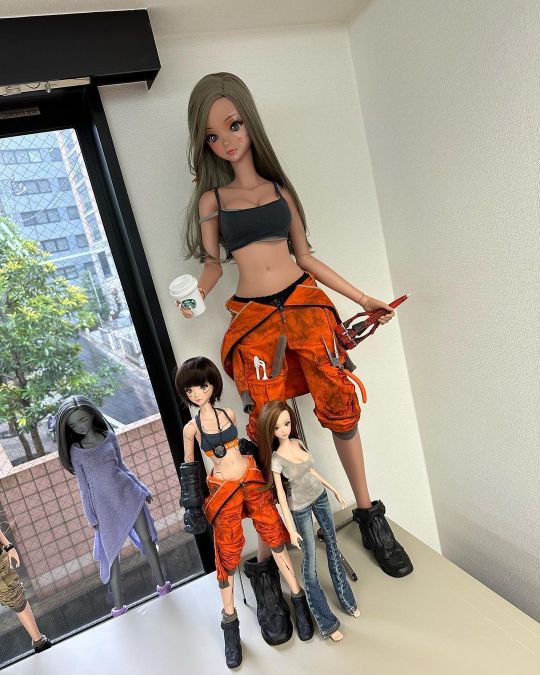
A few updates from Smart Doll Land in no particular order ;-) I uploaded some free Smart Doll apparel patterns to the usual “free stuff” section for the Tube Skirt, Women’s Suit, and Capri Pants that some of you requested. Why buy our stuff when you can make and sell your own?! Any more requests? I’m in the middle of digitizing the Solar Marine uniforms that some of you requested. If you are a seamstress accepting commissions to make apparel with our patterns, leave a comment so folks can find you. The free STL data for the Adventurer Bust is also available - it didn’t make the cut so it’s yours. We may revisit this in the future, but the top priority is the pear-shaped plus-sized body. Do not send the data for printing expecting it to be in the size you require - you need to spend effort in figuring out print sizes - some of the data is for prototypes, so they may be tiny/huge and require modding. Output will still vary based on your printer settings and filament/resin shrinkage sizes. If you are unsure, seek some of the 3D engineers in the community like @mikela_frost and @Ardichan_smd who offer commissioned services for data modding and printing. —— The gray Evolve frame is nearly ready and will be on the latest version which has tweaks based on the feedback form. The minor changes will be outlined in the changelog. —— The Cybershell bodies have been challenging when it comes to production. As always, it’s easy to make a couple - but not so easy to get consistent results when you need to make hundreds. We hope to have a batch in April/May, but releases won’t be as often due to the resources needed to paint them. Even with paint masks, paint tends to blur depending on the individually cast vinyl component shape - ending up with rejects that go to the chaos outlet. —— The Mecha Gauntlet can be converted into Mecha Boots it seems! Discovered with some serendipity, they look pretty decent when coupled with the Bio Mecha Boots - I’ll give you details on how to mod when released. ——- We have been able to awaken more girls from cryosleep - announcements are made on the @smartdollland account (link in bio). #tokyo #smartdoll #anime #manga #3dprinting #japan (at Mirai Store Tokyo) https://www.instagram.com/p/CqHwJJiyIkf/?igshid=NGJjMDIxMWI=
17 notes
·
View notes
Photo
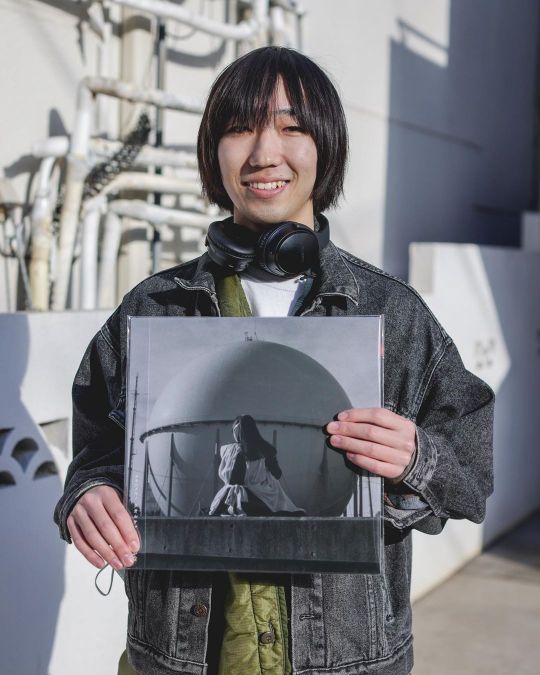
I met Yuto 22-year old outside Coconuts as I was rolling up on the motorcycle and he was heading out, holding in his hand a recent core. I killed the engine and grabbed his attention before he could dash away. As I began to explain to him that I was a photographer and wanted to make his portrait, rather than initial suspicion, he was nothing but good vibes and warm smiles. A can badge on his jean jacket caught my eye – “Have you hugged a mutant today?” Then I noticed one untied Chuck Taylor, then a flannel layer, a sorta ‘67 Beatle-y haircut, and a general slacker posture/strut (which I say very endearingly), dare I say there was something about him that instantly reminded me of, perhaps, a Japanese version of myself 20 (or 25) years ago. When I asked Yuto what he scored, and he very proudly pulled out Kaneko Ayano’s new album “タオルケットは穏やかな” (which is incredibly good - I just listened - Yuto has great taste). “Are you new to records?” I asked Yuto. “I just got a record player and started collecting! This is about my 10th record!” NIIIICE. Yuto and I talked about hi-fi’s, about analog vs. streaming, file bitrate and DACs (Digital Audio Converters) and I could just tell, he had the exact same enthusiasm that I had when I started seriously collecting when I was about his age. And though my excitement for records and record stores has never really waned, I’m noticing that as I get older, I get really excited when I see young people just starting out. Their interest makes ME more interested. Its cool that way. I hope I bump into Yuto again out there. He mentioned that he also is a surfer. So if you don’t bump into him at the record, you might see him catching waves in Ibaraki where he surfs! One last friendly reminder too - tomorrow is the first edition of Tokyo Record Style Day in Shimokitazawa at Flash Disc Ranch from 2pm. Check a few posts back or the event page on Facebook :-) #Tokyo #record #style #tokyorecordstyle #records #music #recordcollector #recordstore #vinyl #vinylcollector #vinylrecords #vinylrecord #rock #Pop #PopRock #Folk #Country #Japan #coconuts (at ココナッツディスク 吉祥寺店) https://www.instagram.com/p/Cn9lcopP6rD/?igshid=NGJjMDIxMWI=
#tokyo#record#style#tokyorecordstyle#records#music#recordcollector#recordstore#vinyl#vinylcollector#vinylrecords#vinylrecord#rock#pop#poprock#folk#country#japan#coconuts
3 notes
·
View notes
Text
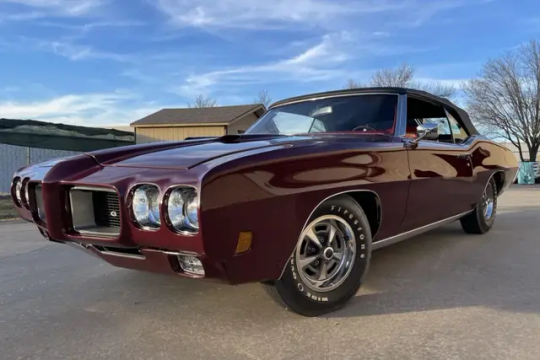
This 1970 Pontiac GTO convertible was first delivered to the A.C. Morris Garage of Summersville, West Virginia, and during prior ownership it underwent a body-off rotisserie refurbishment that was completed in 2006. The car is claimed to be one of just 241 examples that were ordered with 455ci V8 and an optional automatic transmission for the model year, and it is finished in Burgundy over red vinyl upholstery. Other equipment includes a four-barrel carburetor, a Ram Air hood, a power-operated convertible top, power steering, front disc brakes, and a 12-bolt rear end housing a Safe-T-Track limited-slip differential. Acquired by the selling dealer in 2013 out of Arizona, this GTO convertible is offered in Missouri with refurbishment photos, manufacturer’s literature, build sheets, a reproduction window sticker, documentation from Pontiac Historical Services, correspondence with the GM Heritage center, and a clean Missouri title.
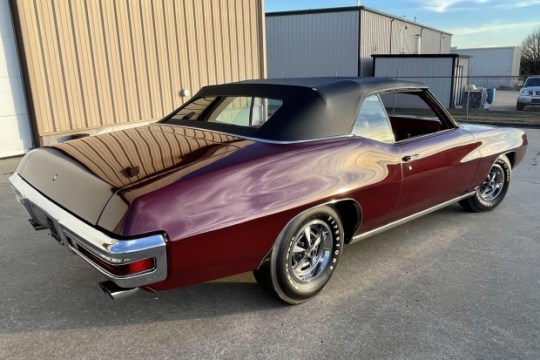
The car was finished from the factory in Burgundy, and the body was stripped, mounted to a rotisserie jig, and repainted during the refurbishment, at which time a replacement convertible top was installed. Features include a color-matched Endura front bumper, a chrome rear bumper, a Ram Air hood, and quad exhaust outlets with polished finishers.
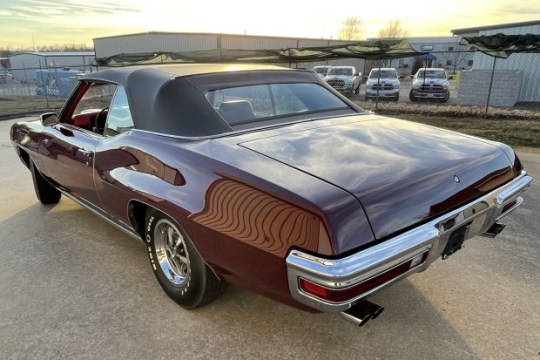
Rally II 14″ wheels are mounted with 215/70 Firestone Wide-Oval tires. Braking is provided by power-assisted front discs and rear drums, and the car was optioned with power steering when new.

The cabin has been retrimmed with red vinyl upholstery (2254) as well as color-coordinated carpets and interior trim. Equipment includes front bucket seats and a rear bench, a woodgrain steering wheel, an AM/FM radio, and an 8-track player. A pre-delivery-style instruction tag is attached to the steering column, and Pontiac-branded rubber floor mats line the front and rear footwells.
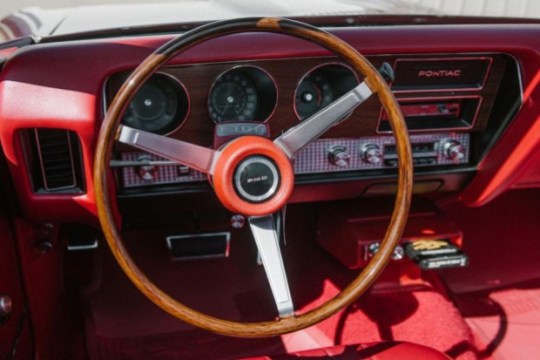
The turned metal and woodtone trim-accented cluster houses Rally instrumentation consisting of a 140-mph speedometer, a tachometer, and a combination gauge. The five-digit odometer shows under 96k miles, approximately 50 of which have been driven by the seller. True mileage is unknown.
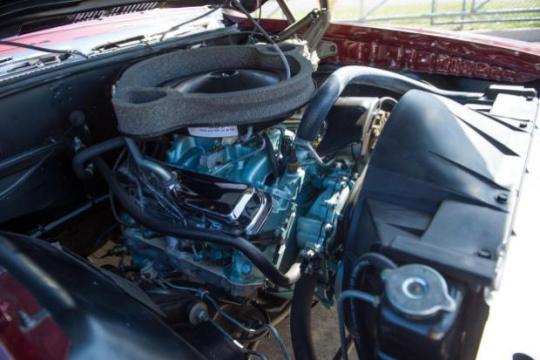
The optional 455ci V8 features a four-barrel carburetor and a Ram Air hood, and it produced a factory-rated 360 horsepower and 500 lb-ft of torque when new. The engine stamping shown within the gallery ends in 0P121234, which matches the final eight digits of the car’s serial number. Additional identification numbers are presented in the gallery.
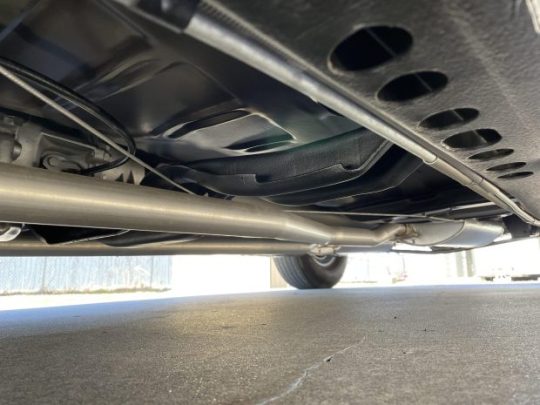
Power is sent to the rear wheels through an optional Turbo Hydramatic 400 three-speed automatic transmission and a 12-bolt rear end housing a Safe-T-Track limited-slip differential. Additional photos are provided in the gallery to illustrate the underside, drivetrain, and suspension components.

Photos showing various stages of the refurbishment are depicted above.
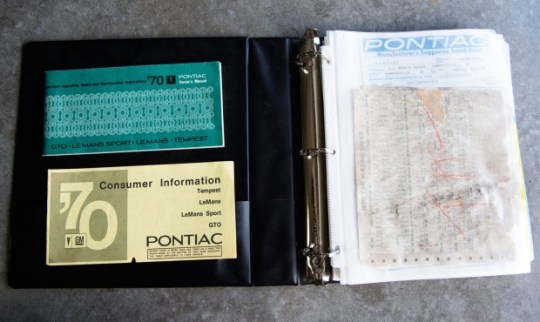
Additional items accompanying the car include manufacturer’s literature, build sheets, a reproduction window sticker, documentation from Pontiac Historical Services, and 2012 correspondence with the GM Heritage center confirming the car’s specifications and equipment, photos of which are provided in the gallery.
24 notes
·
View notes
Text
A CD player skipping when bumped is annoying, but it's really amazing that they can play as well as they do.
Data on a CD is stored as a series of "pits" (indentations) and "lands" (non-indented sections) in a single track that spirals from the inside to the outside. Each pit is only 500 nanometers wide, 100 nanometers deep, and between 850 and 3,500 nanometers long, and the center-to-center distance between successive loops of the track is only 1,600 nanometers. That means there are 15,875 loops per inch or 6,250 loops per centimeter. For reference, a typical E. coli bacterium is a tiny tube between 250 and 1,000 nanometers in diameter and about 2,000 nanometers long. To top it off, when played a CD is spun between 200 and 500 times per minute.
A CD is read with a tiny laser that bounces off of the "pits" and "lands" into a photodiode that converts the laser light into an electrical signal. That laser needs to be accurately aimed at something the size of a single bacterium whizzing by at up to 1.4 meters per second, and it has to be able to move to follow the entire spiraling track. And CDs are inexpensive, mass-produced pieces of plastic — they may be slightly thicker or thinner in some places, or they may be slightly warped, or the center hole might not be perfectly centered. Which means they can wobble as they're spun, both side-to-side and up-and-down, even if the CD player is rock-solid. And the laser needs to track all of that motion perfectly or else data will be missed.
With a vinyl record you at least have a physical needle riding inside a continuous groove, with the walls of the groove keeping the needle on-track even with significant vibration or physical shocks. A tiny laser focused through a tiny lens doesn't even have that benefit to stability.
Once you start putting CD players in things that move, like cars, you can't rely on assuming the player is rock-solid. Truly portable players like the Discman or Walkman make that even worse. Anti-skip technology is really almost miraculous, despite not being perfect. There are multiple types, ranging from software tricks (like reading ahead, storing the data in a rolling buffer, and playing on a delay; if a skip is detected and the new position is within the buffer, it can fix the problem without affecting the playback at all) to physical tricks (like building the spindle and the laser-and-lens assembly on floating mounts that insulate them from external vibrations, preventing skips entirely). Buffering especially became more effective as digital memory got smaller and cheaper, but that is what ultimately killed the CD player: storing entire songs, then entire albums, then entire libraries in digital memory that fits in your pocket.
Anyway, CDs are awesome. Buy CDs of your favorite albums, rip the audio to WAV files for convenient playback on your computer/phone, and store the physical CDs in a cool, dry, dark box as a backup.
If you have a digital library already and want to go physical, you can burn it to CD-Rs (write once, permanently) or CD-RWs (write and re-write and even erase if you want, like modern computer memory), but these can be less stable than read-only pressed-in-the-factory CDs because they use color-changing dyes or metal layers instead of the 3D pits of read-only CDs. If you have any CD-Rs or CD-RWs, back them up to a more long-term digital or physical medium as soon as possible, or you risk losing their contents to disc rot.
What was your first source of portable music? Walkman? CD player with headphones? MP3 Player? iPod? Phone?
143K notes
·
View notes